Numerical Investigation on Potential Influencing Factors Affecting Drainage Effective Radius of Crossing Borehole
Abstract
:1. Introduction
2. Numerical Model
2.1. Fluid–Solid Coupling Model
- (1)
- Gas seepage Equation
- (2)
- Cross-coupling Equation
- (3)
- Deformation control Equation
2.2. Borehole Parameters
2.3. Model Parameters
3. Results and Discussion
3.1. Simulating the Effect of Borehole Inclination and Engineering Practice
3.2. Effect of Borehole Diameter under Different Drilling Inclination
3.3. Spatial and Temporal Evolutionary Characteristics of the Drainage Effective Radius
4. Conclusions
- (1)
- Borehole inclination angle has a significant influence on the drainage effective radius. When the angle α between the borehole and the coal seam plane is small, The vertical component of the ground stress on the coal seam plane has a larger area of action on the boreholes. It is easy to produce shear deformation in the coal body around the boreholes and the degree of fragmentation increases. At this time, the permeability of the coal body near this borehole increases and the drainage effective radius increases.
- (2)
- The drainage effective radii are different in the dip and strike directions of the seam (X and Y directions). When α is smaller, the drainage effective radius in the dip direction is usually wider. When α is larger (maximum when vertical), the effective radii in the dip and strike directions are nearly equal.
- (3)
- In general, the drainage effective radius increases with the increase in borehole diameter, but there are differences in the effective radius increment at different borehole inclination angles. When α is larger, the borehole diameter increases but the effective radius increment is small, and the influence of borehole diameter on gas drainage is small at this time. When α is smaller, expanding the borehole diameter can significantly increase the effective radius.
- (4)
- The drainage effective radius increases with time, and the fitted curve has a negative exponential relationship and gradually slows down and converges to a certain value. The increment of effective radius is less affected by time after t = 60 d, and the increment is close to 0 after t = 80 d. The residual gas pressure curve is very close after t = 50 d, so there is a reasonable interval of time for pre-drainage gas.
Author Contributions
Funding
Institutional Review Board Statement
Informed Consent Statement
Data Availability Statement
Conflicts of Interest
References
- Zou, J.; Zhang, R.; Zhou, F.; Zhang, X. Hazardous Area Reconstruction and Law Analysis of Coal Spontaneous Combustion and Gas Coupling Disasters in Goaf Based on DEM-CFD. ACS Omega 2023, 8, 2685–2697. [Google Scholar] [CrossRef] [PubMed]
- Yuan, L. Research progress of mining response and disaster prevention and control in deep coal mines. J. China Coal Soc. 2021, 46, 716–725. [Google Scholar] [CrossRef]
- Lin, B.; Song, H.; Yang, W.; Zhao, Y.; Cha, W. Study on effective gas drainage area based on anisotropic coal seam. Coal Sci. Technol. 2019, 47, 139–145. [Google Scholar] [CrossRef]
- Cheng, Y.; Yu, Q. Development of Regional Gas Control T echnology for Chinese Coalmines. J. Min. Saf. Eng. 2007, 4, 383–390. [Google Scholar]
- Zhang, X.; Zhou, F.; Zou, J. Numerical Simulation of Gas Extraction in Coal Seam Strengthened by Static Blasting. Sustainability 2022, 14, 12484. [Google Scholar] [CrossRef]
- Li, Y.; Zhai, C.; Ding, X. Technology and application of dynamic pressure gas secondary drainage through borehole in bottom drainage roadway of high gas outburst coal seam. Saf. Coal Mines 2022, 53, 191–196. [Google Scholar] [CrossRef]
- Zhou, H.; Cheng, Y.; Liu, H.; Guo, P.; Wang, L. Permeability improvement technology of array crossing boreholes and its application in outburst coal seam. J. China Coal Soc. 2011, 36, 1515–1518. [Google Scholar] [CrossRef]
- Gao, X.; Shao, G.; Yang, H. Design and application of pump-free double channel mechanical hole enlarging bit for gas penetration in middle hard coal seam. Coal Geol. Explor. 2022, 50, 159–164. [Google Scholar]
- Yuan, Z.; Wang, H.; Hu, G.; Fan, X.; Liu, N. Numerical simulation of hydraulic fracturing of crossing borehole and its engineering application. J. China Coal Soc. 2012, 37, 109–114. [Google Scholar] [CrossRef]
- Li, K.; Zhu, C.; Liu, S.; Chen, D.; Cai, G. Effects of Injection Pressure and Duration on Alternate High-Pressure Water-Gas Sequestration of Coalbed Methane. Geofluids 2022, 2022, 1–15. [Google Scholar] [CrossRef]
- Liu, Z.; Cheng, Y.; Jiang, J.; Li, W.; Jin, K. Interactions between coal seam gas drainage boreholes and the impact of such on the borehole patterns. J. Nat. Gas Sci. Eng. 2017, 38, 597–607. [Google Scholar] [CrossRef] [Green Version]
- Jia, L.; Peng, S.; Xu, J.; Yan, F.; Chen, J.; Wu, B. Investigation on gas drainage effect under different borehole layout via 3D monitoring of gas pressure. J. Nat. Gas Sci. Eng. 2022, 101, 104522. [Google Scholar] [CrossRef]
- Lyo, Y.; Zhu, C. Study on attenuation law of gas drainage flow in borehole passed through seam with different inclined floor. Coal Sci. Technol. 2017, 45, 74–79. [Google Scholar] [CrossRef]
- Zhou, Y.; Liang, B.; Shi, Z.; Sun, W.; Liu, X. Theoretical study on the drilling cuttings considering coal seam angle and borehole angle. Min. Saf. Environ. Prot. 2020, 47, 26–30,35. [Google Scholar] [CrossRef]
- Lin, H.; Liu, S.; Li, S.; Shuang, H.; Kong, X.; Chen, C.; Xiao, P.; Xu, P. Experimental study for the effects of drilling angle on coal mass stability under stable pressure conditions. J. Min. Saf. Eng. 2021, 38, 575–583. [Google Scholar] [CrossRef]
- Wang, Y.; Yang, L.; Fan, C. Effective drainage area and parameter optimization of bedding drilling in high gas and thick coal seam. Saf. Coal Mines 2022, 53, 212–221. [Google Scholar] [CrossRef]
- Yu, Y.; Zhu, J.; Zheng, J.; Huang, X.; Zhang, L.; Zhang, J. Study on Deformation and Strength Characteristics of Xi’an Loess by Borehole Shear Tests. J. Disaster Prev. Mitig. Eng. 2022, 42, 1104–1112,1120. [Google Scholar] [CrossRef]
- Zhang, X.; Wang, H.; Yang, M.; Wang, P. Study and application on influence mechanism of instability and collapse of drainage borehole on gas drainage. J. China Coal Soc. 2022, 1–15. [Google Scholar] [CrossRef]
- Yang, T.; Chen, S.; Zhu, W.; Liu, H. Coupled model of gas flow-solid distortion in coal seams based on dynamic process of pressure relief and gas drainage. Rock Soil Mech. 2010, 2247–2252. [Google Scholar] [CrossRef]
- Li, S.; Jiang, C.; Yao, J.; Li, M. Solid-gas coupling model and numerical simulation of coal containing gas based on comsol multiphysic. In Proceedings of the 8th National Conference on Rock Mechanics and Engineering Experimentation and Testing Technology, Changchun, China, 8–10 August 2012; pp. 446–451. Available online: https://d.wanfangdata.com.cn/conference/ChZDb25mZXJlbmNlTmV3UzIwMjIxMDEyEgc3OTc5MDYxGghwbTloOGI5cQ%3D%3D (accessed on 30 October 2022).
- Lu, Y.; Jia, Y.; Ge, Z.; Xia, B. Coupled fluid-solid model of coal bed methane and its application after slotting by high-pressure water jet. J. China Univ. Min. Technol. 2014, 43, 23–29. [Google Scholar] [CrossRef]
- Zhu, Y.; Tao, G.; Fang, W.; Wang, S. Research progress of the klinkenberg effect in tight gas reservoir. Prog. Geophys. 2007, 5, 1591–1596. [Google Scholar]
- Yin, G.; Li, M.; Li, S.; Li, W.; Yao, J.; Zhang, Q. 3D numerical simulation of gas drainage from boreholes based on solid gas coupling model of coal containing gas. J. China Coal Soc. 2013, 38, 535–541. [Google Scholar] [CrossRef]
- Mitra, A.; Harpalani, S.; Liu, S. Laboratory measurement and modeling of coal permeability with continued methane production: Part 1—Laboratory results. Fuel 2012, 94, 110–116. [Google Scholar] [CrossRef]

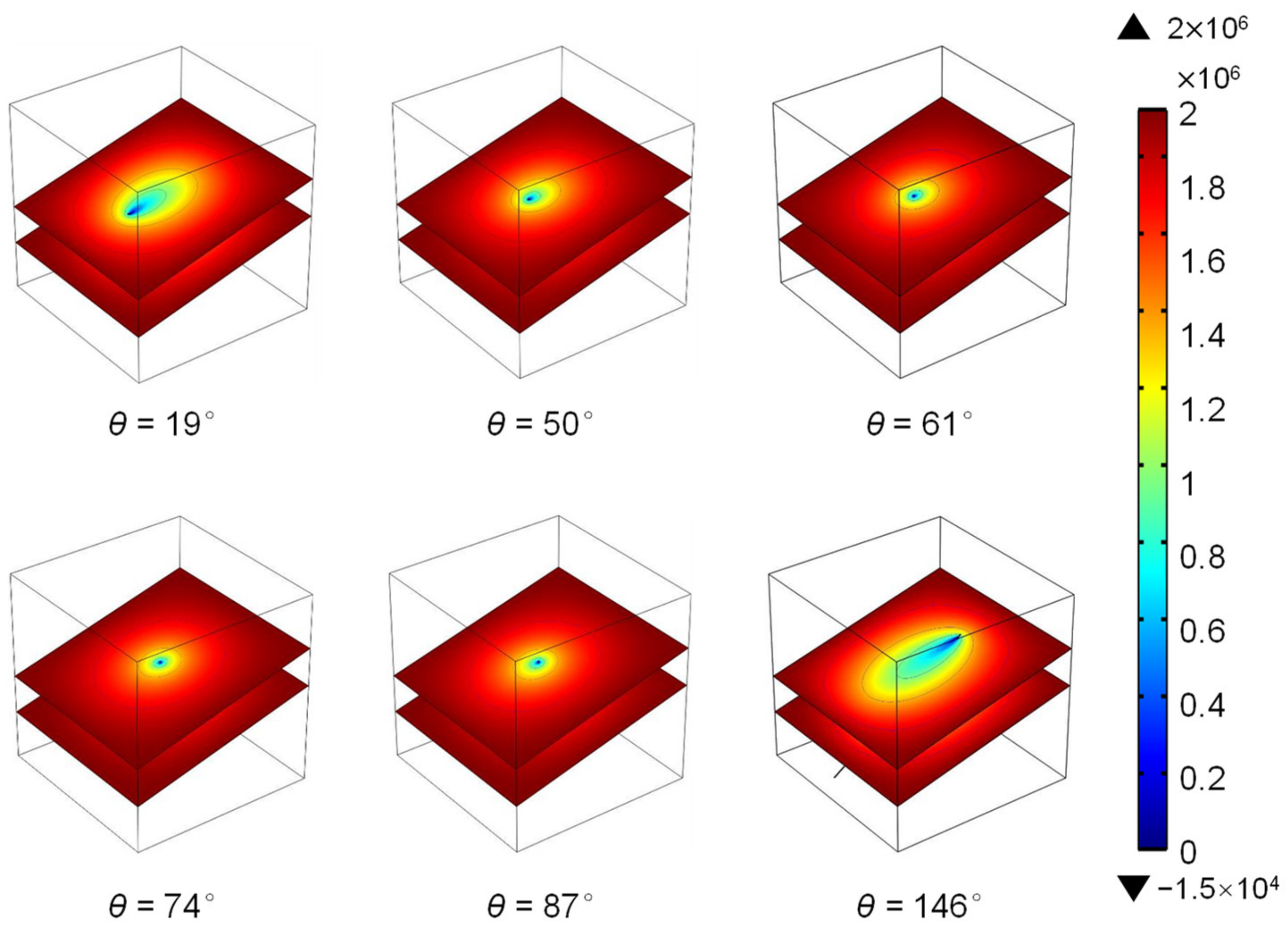
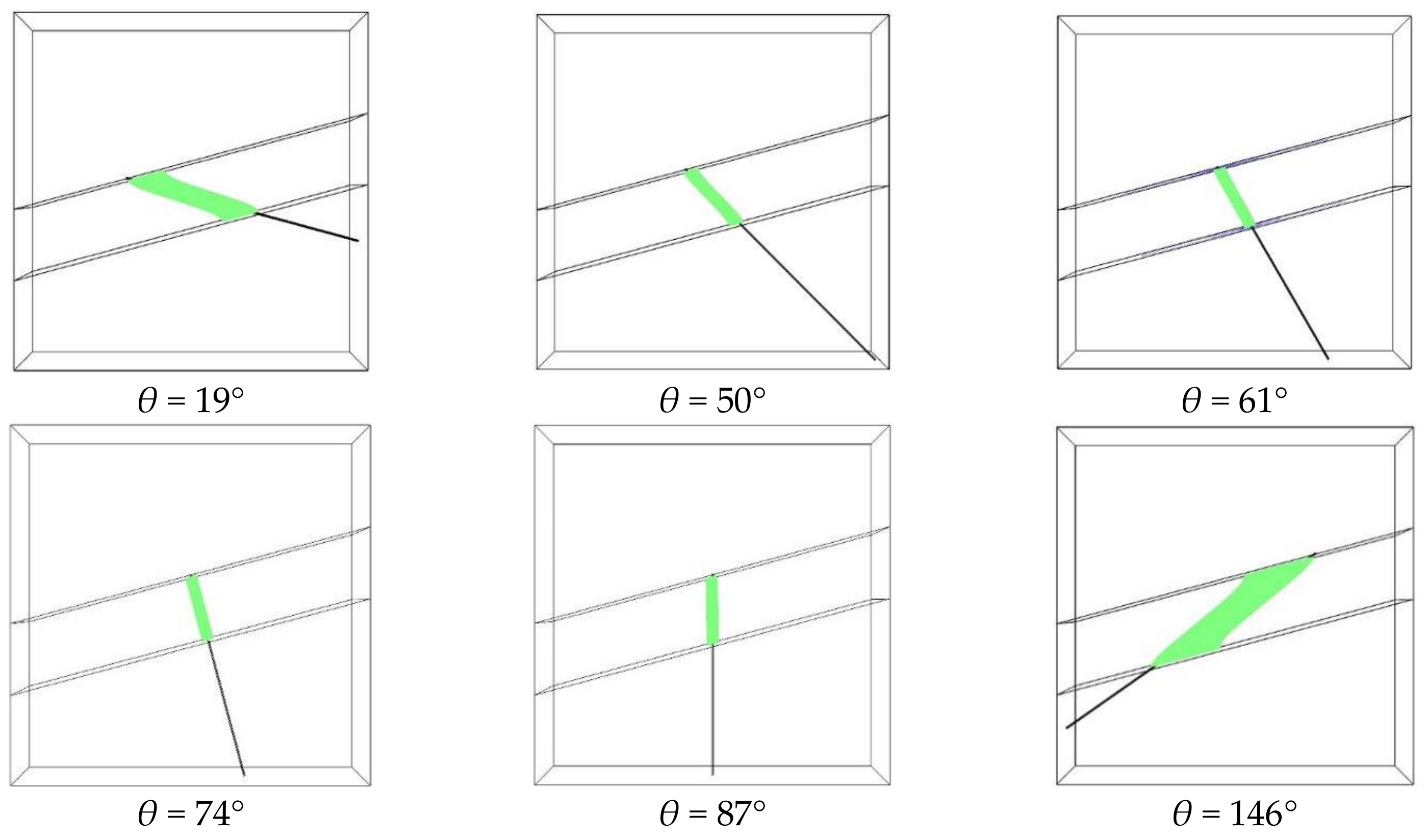



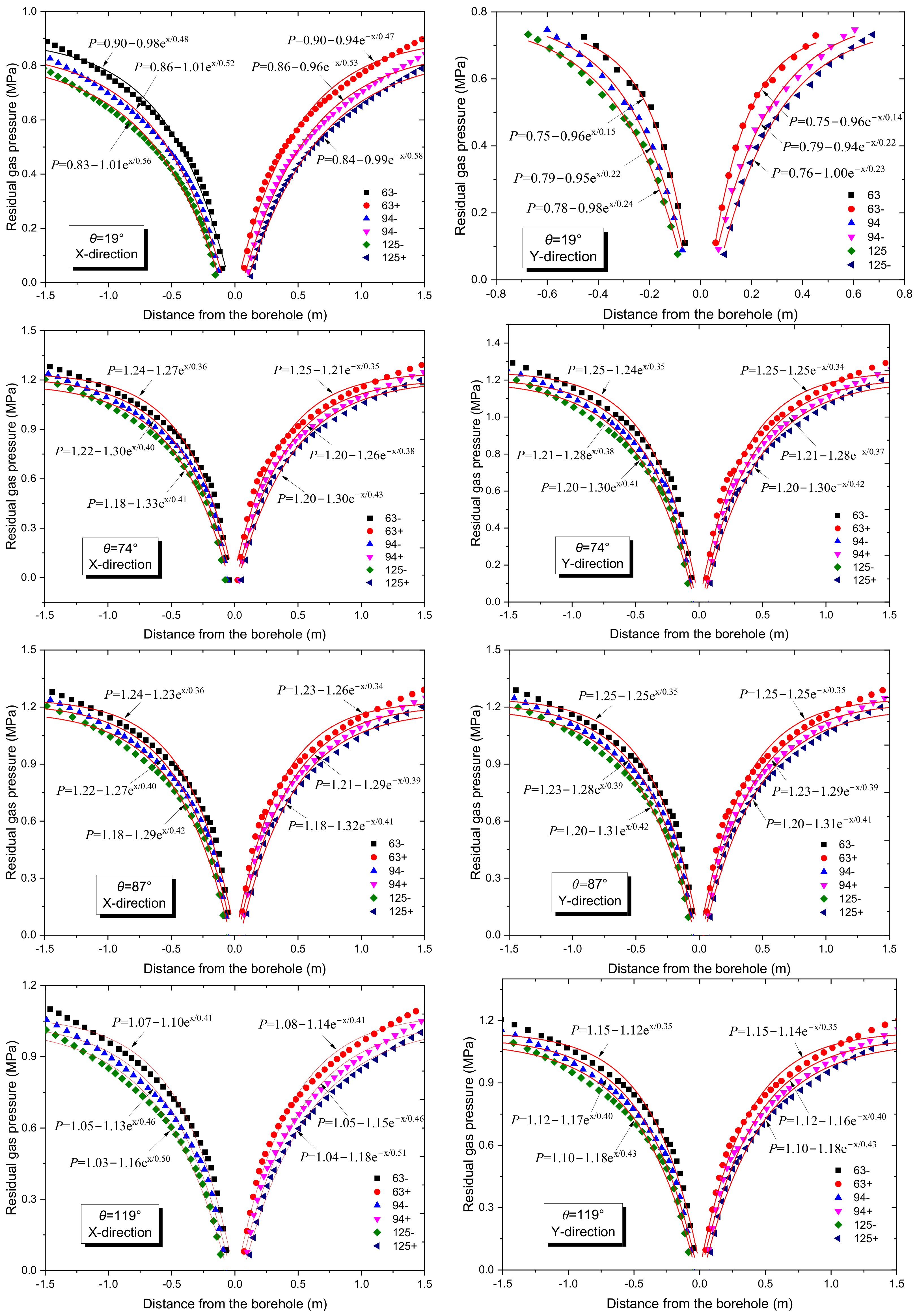
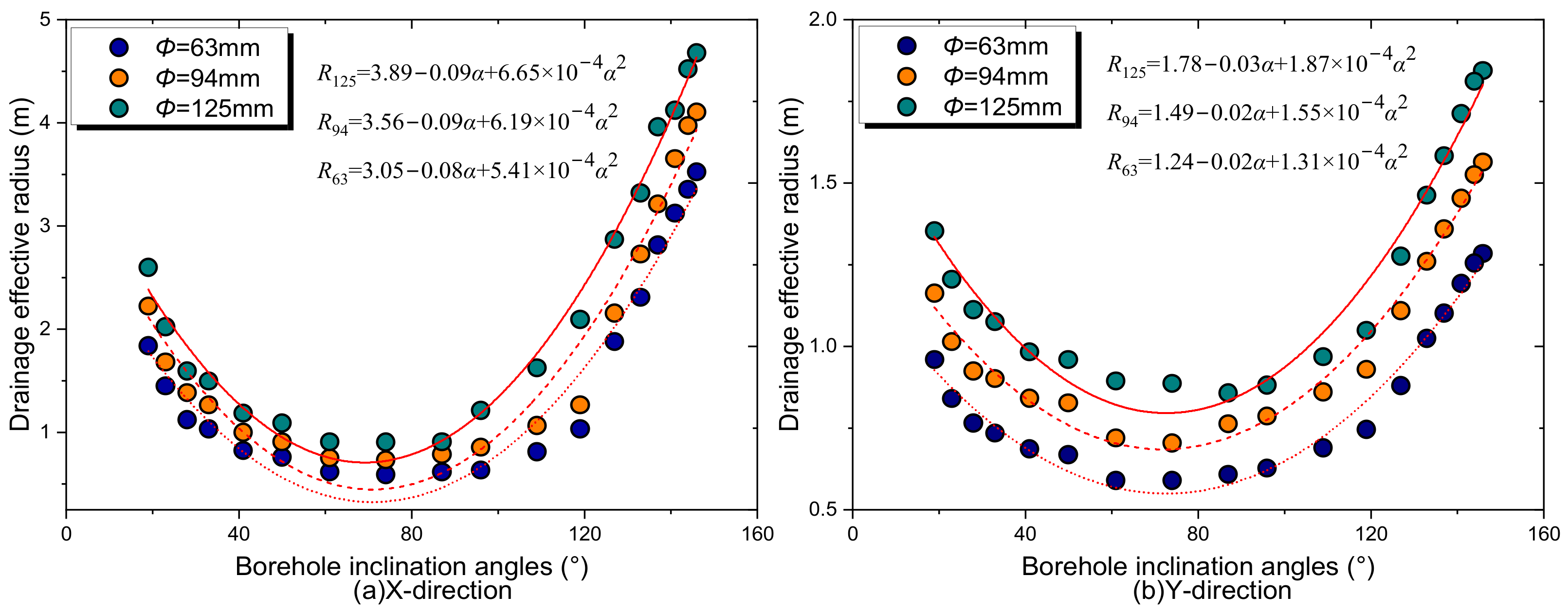
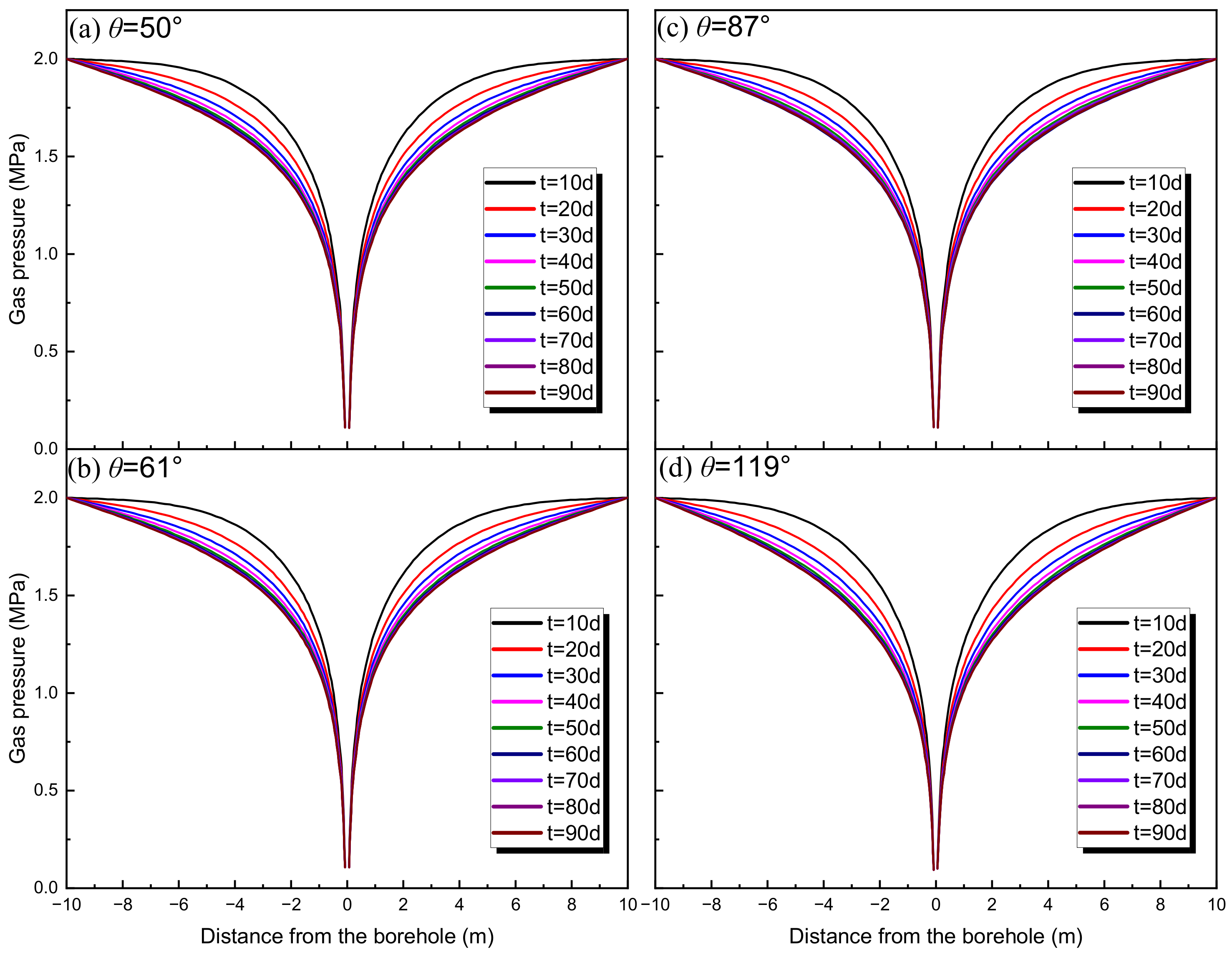
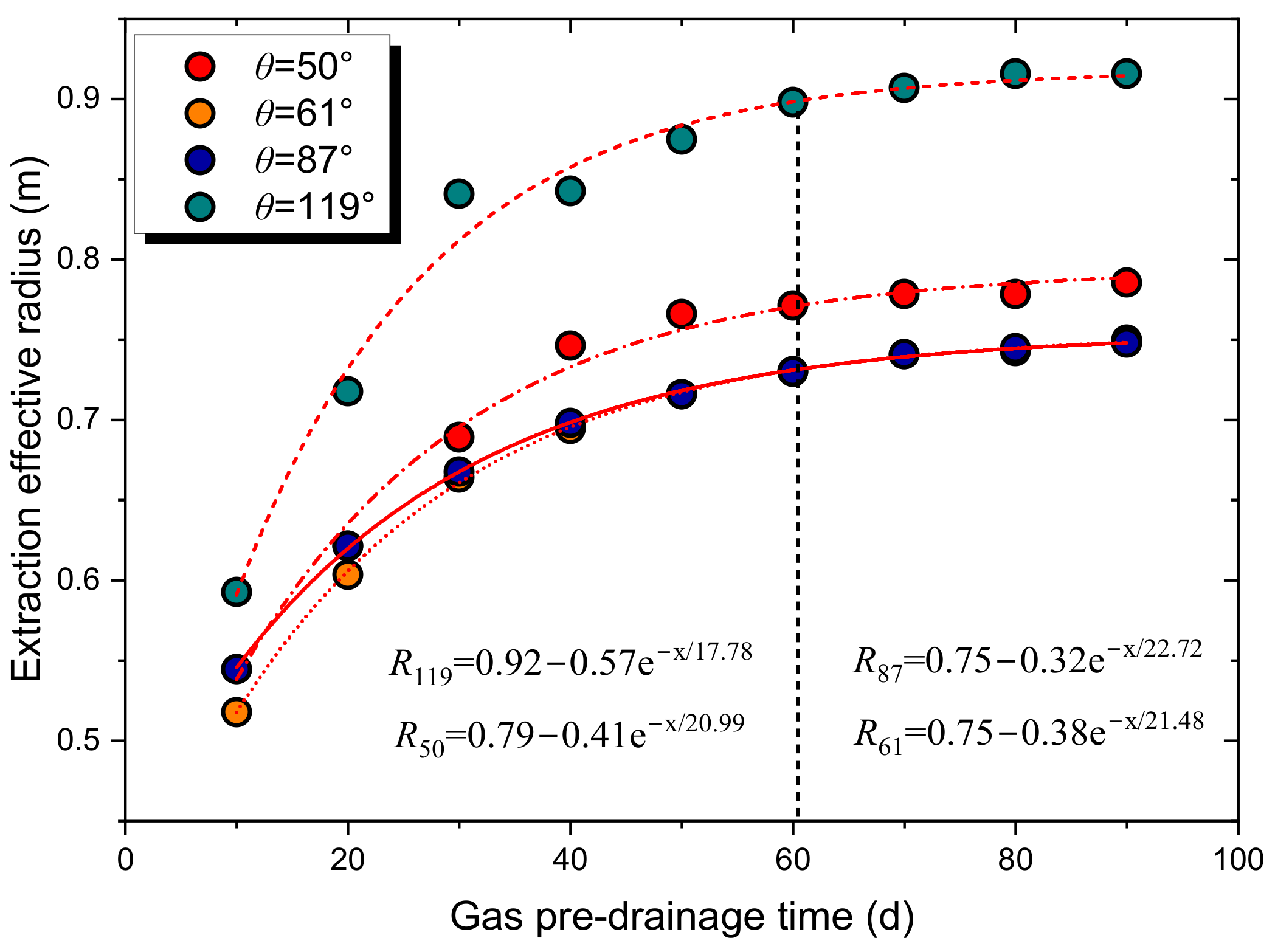
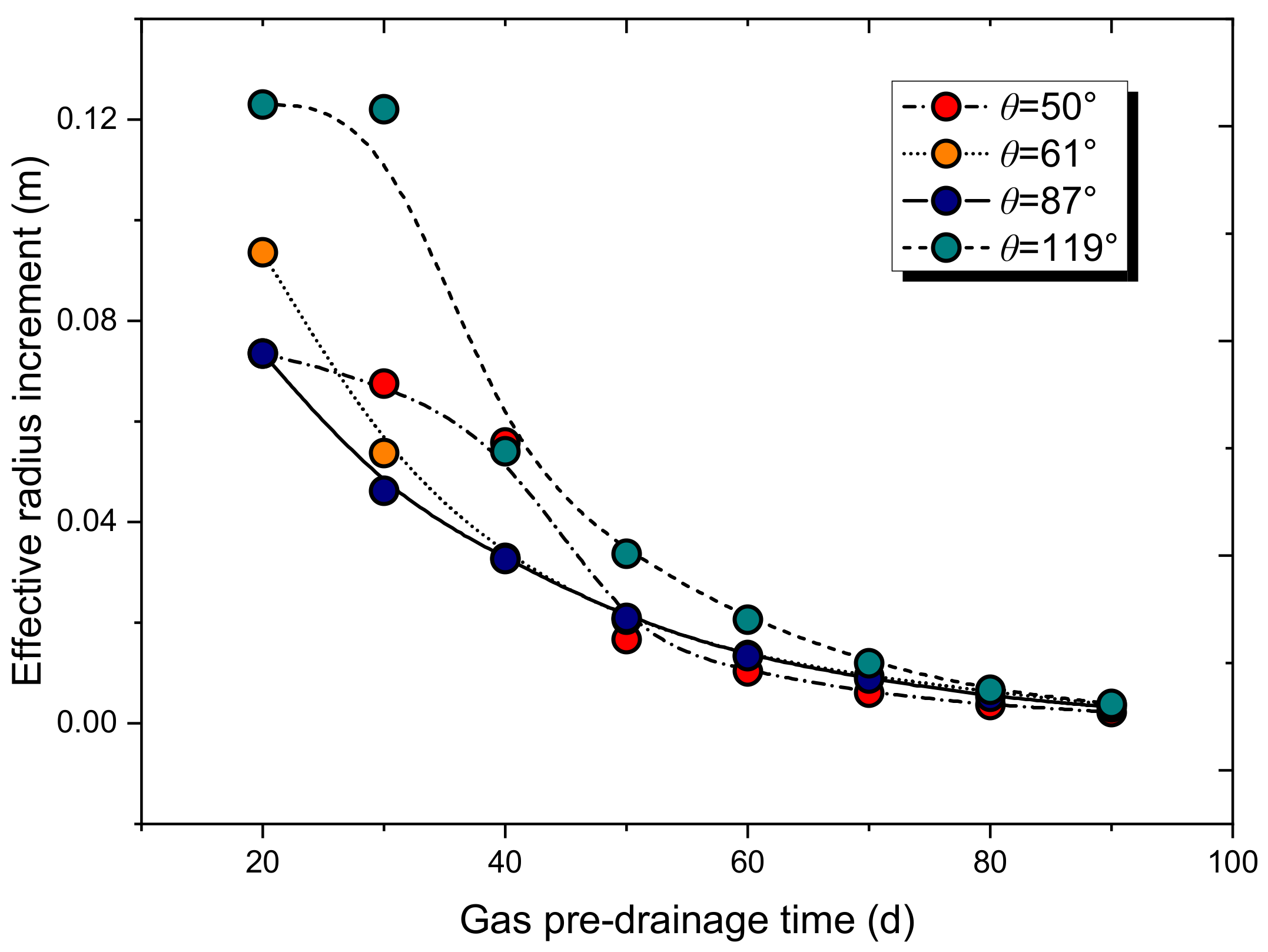
| Hole No. | Inclination Angle (°) | Diameter (mm) | Azimuth Angle (°) | Hole Depth (m) | Hole No. | Inclination Angle (°) | Diameter (mm) | Azimuth Angle (°) | Hole Depth (m) |
|---|---|---|---|---|---|---|---|---|---|
| 1 | 146 | 89 | 214.5 | 53 | 10 | 87 | 89 | 34.5 | 20 |
| 2 | 144 | 89 | 214.5 | 48 | 11 | 74 | 89 | 34.5 | 20 |
| 3 | 141 | 89 | 214.5 | 43 | 12 | 61 | 89 | 34.5 | 22 |
| 4 | 137 | 89 | 214.5 | 39 | 13 | 50 | 89 | 34.5 | 23 |
| 5 | 133 | 89 | 214.5 | 35 | 14 | 41 | 89 | 34.5 | 25 |
| 6 | 127 | 89 | 214.5 | 30 | 15 | 33 | 89 | 34.5 | 29 |
| 7 | 119 | 89 | 214.5 | 28 | 16 | 28 | 89 | 34.5 | 33 |
| 8 | 109 | 89 | 214.5 | 25 | 17 | 23 | 89 | 34.5 | 36 |
| 9 | 96 | 89 | 214.5 | 21 | 18 | 19 | 89 | 34.5 | 40 |
| Parameter and Unit | Parameter Value | Parameter and Unit | Parameter Value |
|---|---|---|---|
| Modulus of elasticity of coal body, E/(Pa) | 1.2 × 109 | Friction angle of coal body, φ/(°) | 32 |
| Poisson’s ratio of coal body, υ | 0.2 | Rock Young’s modulus, E/(Pa) | 2.7 × 1010 |
| Initial penetration rate, k0/(m2) | 5 × 10−14 | Poisson’s ratio of rock layer, υ | 0.17 |
| Initial porosity, φ0 | 0.0604 | Rock density, ρyan/(kg/m3) | 2600 |
| Maximum penetration rate, km/(m2) | 4.5 × 10−13 | Adsorption constants, ag/(m3/kg) | 14.1 |
| Maximum porosity, φm | 0.0650 | Adsorption constants, bg/(1/MPa) | 0.77 |
| Density of coal body, ρc/(kg/m3) | 1500 | Gas power viscosity, μ/(Pa·s) | 1.84 × 10−5 |
| Cohesion of coal body, C/(Pa) | 3 × 106 | Gas density, ρg/(kg/m3) | 0.717 |
Disclaimer/Publisher’s Note: The statements, opinions and data contained in all publications are solely those of the individual author(s) and contributor(s) and not of MDPI and/or the editor(s). MDPI and/or the editor(s) disclaim responsibility for any injury to people or property resulting from any ideas, methods, instructions or products referred to in the content. |
© 2023 by the authors. Licensee MDPI, Basel, Switzerland. This article is an open access article distributed under the terms and conditions of the Creative Commons Attribution (CC BY) license (https://creativecommons.org/licenses/by/4.0/).
Share and Cite
Xiao, W.; Li, K.; Zhu, C.; Li, Z.; Lin, B.; Ma, C.; Si, M. Numerical Investigation on Potential Influencing Factors Affecting Drainage Effective Radius of Crossing Borehole. Sustainability 2023, 15, 2485. https://doi.org/10.3390/su15032485
Xiao W, Li K, Zhu C, Li Z, Lin B, Ma C, Si M. Numerical Investigation on Potential Influencing Factors Affecting Drainage Effective Radius of Crossing Borehole. Sustainability. 2023; 15(3):2485. https://doi.org/10.3390/su15032485
Chicago/Turabian StyleXiao, Wu, Ke Li, Chuanjie Zhu, Ziwen Li, Baiquan Lin, Cong Ma, and Mingkai Si. 2023. "Numerical Investigation on Potential Influencing Factors Affecting Drainage Effective Radius of Crossing Borehole" Sustainability 15, no. 3: 2485. https://doi.org/10.3390/su15032485





